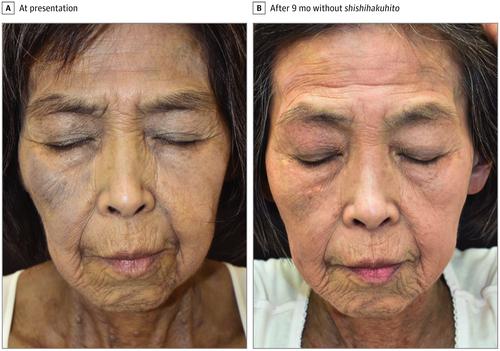JAMA Dermatology ( IF 10.9 ) Pub Date : 2020-02-05 , DOI: 10.1001/jamadermatol.2019.4682 Megumi Mizawa 1 , Tsugunobu Andoh 2 , Tadamichi Shimizu 1

|
Gardenia fruit is widely used in herbal medicine, and it has choleretic, sedative, diuretic, anti-inflammatory, and antipyretic effects.1 An ingredient of gardenia fruit is attracting attention as a possible cause of mesenteric phlebosclerosis, which is characterized by fibrotic change or calcification of the mesenteric vein and the bronze coloration of the colonic membrane.2 Mesenteric phlebosclerosis may cause abdominal pain, stool abnormalities, and bowel obstruction, but it is often asymptomatic. It is suggested that genipin, a metabolite of geniposide (the major ingredient of gardenia fruit) is involved in the bronze coloration. Herein, we describe a patient who took the extract of gardenia fruit for 7 years, developed skin pigmentation complicated with mesenteric phlebosclerosis.
中文翻译:

ia子果实相关的蓝灰色皮肤色素沉着。
ia子果实被广泛用于草药中,具有利胆,镇静,利尿,消炎和解热的作用。1 garden子果实的一种成分引起了人们的关注,它可能是引起肠系膜静脉硬化的原因,其特征是肠系膜纤维化或钙化,结肠膜呈青铜色。2肠系膜静脉硬化症可引起腹痛,大便异常和肠梗阻,但通常无症状。有人指出,古尼平是,子糖苷的一种代谢产物(of子果实的主要成分),可能与古铜色有关。在本文中,我们描述了一位服用took子果实提取物7年,皮肤色素沉着并伴有肠系膜静脉硬化的患者。



























 京公网安备 11010802027423号
京公网安备 11010802027423号